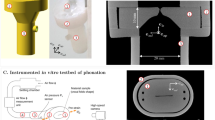Abstract
The vocal folds (VFs) are connective tissues with complex matrix structures that provide the required mechanical properties for voice generation. VF injury leads to changes in tissue structure and properties, resulting in reduced voice quality. However, injury-induced biochemical changes and repair in scarred VF tissues have not been well characterized to date. To treat scarred VFs, it is essential to understand how physiological characteristics of VFs tissue change in response to external perturbation. In this study, we designed a simple vibrational culture model to mimic vibratory microenvironments observed in vivo. This model consists of a flexible culture plate, three linear actuators, a stereo splitter, and a function generator. Human vocal fold fibroblast (hVFF) monolayers were established on the flexible membrane, to which normal phonatory vibrations were delivered from linear actuators and a function generator. The hVFF monolayers were exposed to the vibrational stresses at a frequency of 205 Hz for 2, 6, and 10 h with maximum displacement of 47.1 μm, followed by a 6 h rest. We then observed the changes in cell morphology, cell viability, and gene expression related to extracellular matrix components. In our dynamic culture device mimicking normal phonatory frequencies, cell proliferation increased and expression of hyaluronic acid synthase 2 was downregulated in response to vibrational stresses. The results presented herein will be useful for evaluating cellular responses following VF injuries in the presence or absence of vibrational stresses.






Similar content being viewed by others
References
Brown, Jr, W. S., R. J. Morris, H. Hollien, and E. Howell. Speaking fundamental frequency characteristics as a function of age and professional singing. J. Voice 5:310–315, 1991.
Bustin, S. A. Quantification of mRNA using real-time reverse transcription PCR (RT-PCR): trends and problems. J. Mol. Endocrinol. 29:23–39, 2002.
Chan, R. W., S. D. Gray, and I. R. Titze. The importance of hyaluronic acid in vocal fold biomechanics. Otolaryngology 124:607–614, 2001.
Chen, X., and S. L. Thibeault. Novel isolation and biochemical characterization of immortalized fibroblasts for tissue engineering vocal fold lamina propria. Tissue Eng. Part C 15:201–212, 2009.
Chiquet, M., A. S. Renedo, F. Huber, and M. Flück. How do fibroblasts translate mechanical signals into changes in extracellular matrix production? Matrix Biol. 22:73–80, 2003.
Farran, A. J. E., S. S. Teller, F. Jia, R. J. Clifton, R. L. Duncan, and X. Jia. Design and characterization of a dynamic vibrational culture system. J. Tissue Eng. Regen. Med. 7:213–225, 2013.
Gaston, J., B. Quinchia Rios, R. Bartlett, C. Berchtold, and S. L. Thibeault. The response of vocal fold fibroblasts and mesenchymal stromal cells to vibration. PLoS One 7:e30965, 2012.
Gray, S. D. Cellular physiology of the vocal folds. Otolaryngol. Clin. North Am. 33:679–697, 2000.
Gray, S. D., E. Hammond, and D. F. Hanson. Benign pathologic responses of the larynx. Ann. Otol. Rhinol. Laryngol. 104:13–18, 1995.
Henrich, N. Mirroring the voice from Garcia to the present day: some insights into singing voice registers. Logoped. Phoniatr. Vocol. 31:3–14, 2006.
Hirano, M., and K. Sato. Histological Color Atlas of the Human Larynx. San Diego: Singular Publishing Group, 1993.
Hirano, S. Current treatment of vocal fold scarring. Curr. Opin. Otolaryngol. Head Neck Surg. 13:143–147, 2005.
Hirschi, S. D., S. D. Gray, and S. L. Thibeault. Fibronectin: an interesting vocal fold protein. J. Voice 16:310–316, 2002.
Ishii, K., W. G. Zhai, M. Akita, and H. Hirose. Ultrastructure of the lamina propria of the human vocal fold. Acta Otolaryngol. 116:778–782, 1996.
Kutty, J. K., and K. Webb. Tissue engineering therapies for the vocal fold lamina propria. Tissue Eng. 15:249–262, 2009.
Kutty, J. K., and K. Webb. Vibration stimulates vocal mucosa-like matrix expression by hydrogel-encapsulated fibroblasts. J. Tissue Eng. Regen Med. 4:62–72, 2010.
Livak, K. J., and T. D. Schmittgen. Analysis of relative gene expression data using real-time quantitative PCR and the 2−ΔΔCt method. Methods 25:402–408, 2001.
Nagase, H., R. Visse, and G. Murphy. Structure and function of matrix metalloproteinases and TIMPs. Cardiovasc. Res. 69:562–573, 2006.
Sato, K., M. Hirano, and T. Nakashima. Fine structure of the human newborn and infant vocal fold mucosae. Ann. Otol. Rhinol. Laryngol. 110:417–424, 2001.
Smith, E., K. Verdolini, S. Gray, S. Nichols, J. Lemke, J. Barkmeier, H. Dove, and H. Hoffman. Effect of voice disorders on quality of life. J. Med. Speech. Lang. Pathol. 4:223–244, 1996.
Titze, I. R. On the relation between subglottal pressure and fundamental frequency in phonation. J. Acoust. Soc. Am. 85:901–906, 1989.
Titze, I. R., R. W. Hitchcock, K. Broadhead, K. Webb, W. Li, S. D. Gray, and P. A. Tresco. Design and validation of a bioreactor for engineering vocal fold tissues under combined tensile and vibrational stresses. J. Biomech. 37:1521–1529, 2004.
Tran, Q. T., G. S. Berke, B. R. Gerratt, and J. Kreiman. Measurement of Young’s modulus in the in vivo human vocal folds. Ann. Otol. Rhinol. Laryngol. 102:584–591, 1993.
Wolchok, J. C., C. Brokopp, C. J. Underwood, and P. A. Tresco. The effect of bioreactor induced vibrational stimulation on extracellular matrix production from human derived fibroblasts. Biomaterials 30:327–335, 2009.
Wolchok, J. C., and P. A. Tresco. Using vocally inspired mechanical conditioning to enhance the synthesis of a cell-derived biomaterial. Ann. Biomed. Eng. 41:2358–2366, 2013.
Acknowledgments
Funding was provided by an Inha University Research Grant and National Research Foundation of Korea (NRF-2014R1A1A2053565).
Conflict of interest
The authors have no competing interests to declare.
Author information
Authors and Affiliations
Corresponding author
Additional information
Associate Editor Debra T. Auguste oversaw the review of this article.
Rights and permissions
About this article
Cite this article
Kim, D., Lim, JY. & Kwon, S. Development of Vibrational Culture Model Mimicking Vocal Fold Tissues. Ann Biomed Eng 44, 3136–3143 (2016). https://doi.org/10.1007/s10439-016-1587-5
Received:
Accepted:
Published:
Issue Date:
DOI: https://doi.org/10.1007/s10439-016-1587-5




